 W
WAetosauroides is an extinct genus of aetosaur from the Late Triassic of South America. It is one of four aetosaurs known from South America, the others being Neoaetosauroides, Chilenosuchus and Aetobarbakinoides. Three species have been named: the type species A. scagliai, A. subsulcatus and A. inhamandensis. Fossils have been found in the Cancha de Bochas Member of the Ischigualasto Formation in the Ischigualasto-Villa Unión Basin in northwestern Argentina and the Santa Maria Formation in the Paraná Basin in southeastern Brazil. The strata date to the late Carnian and early Norian stages, making Aetosauroides one of the oldest aetosaurs.
 W
WAndescynodon is a genus of traversodontid cynodonts from the Middle Triassic of Argentina. Fossils are known from the Cerro de las Cabras and Cacheutá Formations. Andescynodon is one of the most basal traversodontids. Another traversodontid called Rusconiodon has also been identified from the Cerro de las Cabras Formation but is now considered a junior synonym of Andescynodon.
 W
WThe Chañares Formation is a Carnian-age geologic formation of the Ischigualasto-Villa Unión Basin, located in La Rioja Province, Argentina. It is characterized by drab-colored fine-grained volcaniclastic claystones, siltstones, and sandstones which were deposited in a fluvial to lacustrine environment. The formation is most prominently exposed within Talampaya National Park, a UNESCO World Heritage site within La Rioja Province.
 W
WChanaresuchus is an extinct genus of proterochampsian archosauriform. It was of modest size for a proterochampsian, being on average just over a meter in length. Fossils are known from the Middle and Late Triassic of La Rioja Provence, Argentina and Rio Grande do Sul, Brazil. The type species and only currently known species is Chanaresuchus bonapartei was named from the Ladinian-age Chañares Formation in 1971. A second species C. ischigualastensis named in 2012 from the late Carnian-age Ischigualasto Formation, was briefly assigned to Chanaresuchus before being moved to its own genus Pseudochampsa in 2014. C. bonapartei has recently been found in the Carnian Santa Maria Formation in Brazil. Chanaresuchus appears to be one of the most common archosauriforms from the Chanares Formation due to the abundance of specimens referred to the genus. Much of the material has been found by the La Plata-Harvard expedition of 1964-65. Chanaresuchus was originally classified in the family Proterochampsidae, although it has been placed in the family Rhadinosuchidae in more recent studies.
 W
WChiniquodon is an extinct genus of carnivorous cynodonts, which lived during the Late Triassic (Carnian) in South America and Africa. Chiniquodon is closely related to a contemporary genus, Probelesodon, and close to the ancestry of mammals.
 W
WChoiyoi Group is a Permian and Triassic-aged group of volcano-sedimentary formations in Argentina and Chile. The group bears evidence of bimodal-style volcanism related to an ancient subduction zone that existed along the western margin of the supercontinent Gondwana.
 W
WCladophlebis is an extinct form genus of fern, used to refer to Paleozoic and Mesozoic fern leaves that have "fern fronds with pinnules that are attached to the rachis, and have a median vein that runs to the apex of the pinnule, and veins from that are curved and dichotomise". By convention this genus is not used to refer to fossil ferns from the Cenozoic. Ferns with this morphology belong to several families, including Osmundaceae, Dicksoniaceae and Schizaeaceae. Ferns with this morphology are common during the Paleozoic and Mesozoic in both the northern and southern hemispheres.
 W
WColoradisaurus is a genus of massospondylid sauropodomorph dinosaur. It lived during the Late Triassic period in what is now La Rioja Province, Argentina. It is known from the holotype PVL 5904, nearly complete skull. It was discovered and collected from the upper section of the Los Colorados Formation of the Ischigualasto-Villa Unión Basin.
 W
WCynognathus is an extinct genus of large-bodied cynodontian therapsids that lived in the Middle Triassic. It is known from a single species, Cynognathus crateronotus. Cynognathus was a 1.2-metre long predator closely related to mammals and had a southern hemispheric distribution. Fossils have so far been recovered from South Africa, Argentina, Antarctica, and Namibia.
 W
WDiademodon is an extinct genus of cynodonts. It was about 2 metres (6.6 ft) long. Although Diademodon is the most well accepted name for the genera to date, it was originally named Cynochampsa laniarius by Owen in 1860. The proposed name change occurred in 1982, where Grine defended the name proposed by Harry Seeley: Diademodon tetragonus and to be place in the group Therapsida, which was a group Owen had tiptoed around in his works on paleontology. Though Harry Govier Seeley had named Diademodon in 1894, which was after Owen had dubbed the genus Cynochampsa, Seeley had not realized the two were one and the same as the fossil that Owen named was claimed to have been found in a claystone nodule in the Renosterberg Mountains. A later paleontologist explored the same area where the fossil was claimed to have been found and declared no evidence of Cynognathus fossils.
 W
WDinodontosaurus is a genus of dicynodont therapsid. It was one of the largest herbivores of the Triassic and had a beak corneum. It lived in the Middle Triassic but disappeared in the Upper Triassic.
 W
WEcteninion is an extinct genus of meat-eating cynodonts that lived during the Late Triassic (Carnian) in South America. The type species Ecteninion lunensis was named by R.N. Martinez, C.L. May, and C.A. Forster in 1996. E. lunensis is known from a nearly complete skull of about 11 centimetres (4.3 in) in length. It was found in the Cancha de Bochas Member of the Ischigualasto Formation in the Ischigualasto-Villa Unión Basin in northwestern Argentina. It has been interpreted as a basal eucynodont. The holotype is in the collection of the Universidad Nacional de San Juan.
 W
WThe El Tranquilo Group is a geologic group dating to roughly between 228 and 200 million years ago and covering part of the Late Triassic. The El Tranquilo Group is found in the Austral Basin of Santa Cruz Province of Argentina. Fossil flora and purported fossils of the prosauropod dinosaur Mussaurus have been recovered from the El Tranquilo Sandstone. In older publications, the group was defined as a formation. The group contains the Laguna Colorada Formation.
 W
WEodromaeus was an extinct genus of probable basal theropod dinosaurs from the Late Triassic of Argentina. Like many other of the earliest-known dinosaurs, it hails from the Carnian-age Ischigualasto Formation, within the Ischigualasto-Villa Unión Basin of northwestern Argentina. Upon its discovery, it was argued to be one of the oldest true theropods, supplanting its contemporary Eoraptor, which was reinterpreted as a basal sauropodomorph.
 W
WEoraptor is a genus of small, lightly-built, basal saurischian dinosaur. One of the earliest-known dinosaurs, it lived approximately 231 to 228 million years ago, during the Late Triassic in Western Gondwana, in the region that is now northwestern Argentina. The type and only species, Eoraptor lunensis, was first described in 1993, and is known from several well-preserved skeletons. Eoraptor had heterodont dentition, which suggests that it was omnivorous.
 W
WExaeretodon is an extinct genus of fairly large, low-slung traversodontid cynodonts from the southern parts of Pangea. Four species are known, from various formations. E. argentinus is from the Carnian-age Cancha de Bochas Member of the Ischigualasto Formation in the Ischigualasto-Villa Unión Basin in northwestern Argentina. E. major and E. riograndensis are from the Carnian-age portion of the Santa Maria Formation of the Paraná Basin in southeastern Brazil. E. statisticae is from the Carnian-age Lower Maleri Formation of India.
 W
WFasolasuchus is an extinct genus of rauisuchid. Fossils have been found in the Los Colorados Formation of the Ischigualasto-Villa Unión Basin in northwestern Argentina that date back to the Norian stage of the Late Triassic, making it one of the last rauisuchians to have existed before the order became extinct at the end of the Triassic.
 W
WGracilisuchus is an extinct genus of tiny pseudosuchian from the Late Triassic of Argentina. It contains a single species, G. stipanicicorum, which is placed in the clade Suchia, close to the ancestry of crocodylomorphs. Both the genus and the species were first described by Alfred Romer in 1972.
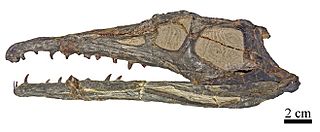 W
WGualosuchus is an extinct genus of proterochampsian archosauriform from the Middle Triassic Chañares Formation of Argentina. The type and only species is Gualosuchus reigi, named by paleontologist Alfred Romer in 1971.
 W
WHerrerasaurus was a genus of saurischian dinosaur from the Late Triassic period. This genus was one of the earliest dinosaurs from the fossil record. Its name means "Herrera's lizard", after the rancher who discovered the first specimen in 1958 in South America. All known fossils of this carnivore have been discovered in the Ischigualasto Formation of Carnian age in northwestern Argentina. The type species, Herrerasaurus ischigualastensis, was described by Osvaldo Reig in 1963 and is the only species assigned to the genus. Ischisaurus and Frenguellisaurus are synonyms.
 W
WHyperodapedon is a genus of rhynchosaurs from the Late Triassic period. Fossils of the genus have been found in Africa, Asia, Europe and North and South America. Its first discovery and naming was found by Thomas Henry Huxley in 1859. Hyperodapedon was a herbivore that used its beaked premaxilla and hindlimbs to dig for plants in dry land.
 W
WIgnotosaurus is an extinct genus of silesaurid dinosauriform known from the Late Triassic (Carnian) Cancha de Bochas Member of the Ischigualasto Formation in the Ischigualasto-Villa Unión Basin in northwestern Argentina. It was therefore contemporary with early dinosaurs such as Herrerasaurus, and lived in the same place.
 W
WIschigualastia is an extinct genus of dicynodonts, that lived during the Carnian age of the Late Triassic Period. The genus was found in and named after the Ischigualasto Formation of the Ischigualasto-Villa Unión Basin in northwestern Argentina. It has been placed in the family Stahleckeriidae.
 W
WThe Ischigualasto Formation is a Late Triassic fossiliferous formation and Lagerstätte in the Ischigualasto-Villa Unión Basin of the southwestern La Rioja Province and northeastern San Juan Province in northwestern Argentina. The formation dates to the Carnian age and ranges between 231.7 and 225 Ma, based on ash bed dating.
 W
WIschigualasto Provincial Park, also called Valle de la Luna, due to its moon like appearance, is a provincial protected area in the north-east of San Juan Province, north-western Argentina, limiting to the north with the Talampaya National Park, in La Rioja Province. Both areas belong to the same geological formation, the Ischigualasto Formation Established on 3 November 1971, the park has an area of 60,370 ha
 W
WLagerpeton is a genus of basal dinosauromorph. First described by A. S. Romer in 1971, it includes only the species L. chanarensis. This species is incompletely known, with fossil specimens accounting for the pelvic girdle, hindlimbs and posterior presacral, sacral and anterior caudal vertebrae.
 W
WLagosuchus is a genus of small avemetatarsalian archosaur from the Middle to Late Triassic period. It is generally thought to be closely related to dinosaurs, as a member of the Dinosauromorpha. Its fossils were found in the Chañares Formation of Argentina, the dating of which is uncertain; some sources date it to the Middle Triassic whilst others date it to the earliest Carnian.
 W
WThe Laguna Colorada Formation is a geological formation of the Austral Basin in Patagonia, Argentina. The formation belongs to the El Tranquilo Group and dates back to the Norian.
 W
WLessemsaurus is an extinct genus of sauropod dinosaur belonging to Lessemsauridae.
 W
WLewisuchus is a genus of archosaur that lived during the Middle Triassic (Ladinian). As a silesaurid dinosauriform, it was a member of the group of reptiles commonly considered to be the closest relatives of dinosaurs. Lewisuchus was about 1 metre (3.3 ft) long. Fossils have been found in the Chañares Formation of Argentina. It exhibited osteoderms along its back.
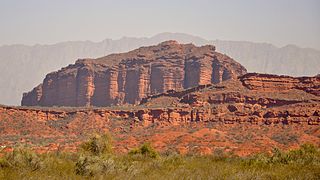 W
WThe Los Colorados Formation is a sedimentary rock formation of the Ischigualasto-Villa Unión Basin, found in the provinces of San Juan and La Rioja in Argentina. The formation dates back to the Norian age of the Late Triassic.
 W
WThe Los Rastros Formation is a Ladinian to Carnian fossiliferous formation of the Agua de la Peña Group in the Ischigualasto-Villa Unión Basin in northwestern Argentina. Fossil theropod tracks, as well as many insects, fossil fish of Myriolepis, bivalves and crustaceans and flora have been reported from the formation.
 W
WLucianovenator is an extinct genus of coelophysoid theropod dinosaur which lived in Argentina during the Triassic. The genus name Lucianovenator translates to "Luciano's hunter", in reference to Don Luciano Leyes, who first reported the remains. The species name bonoi refers to Tulio del Bono, a local scientific authority who collaborated on the describers' research. It is one of the few neotheropods known from South America.
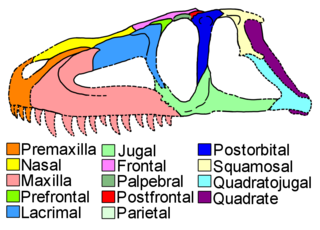 W
WLuperosuchus is an extinct genus of loricatan pseudosuchian reptile which contains only a single species, Luperosuchus fractus. It is known from the Chañares Formation of Argentina, within strata belonging to the latest Ladinian stage of the late Middle Triassic, or the earliest Carnian of the Late Triassic. Luperosuchus was one of the largest carnivores of the Chañares Formation, although its remains are fragmentary and primarily represented by a skull with similarities to Prestosuchus and Saurosuchus.
 W
WMarasuchus is a genus of basal dinosauriform archosaur which is possibly synonymous with Lagosuchus. Both genera lived during the Late Triassic in what is now La Rioja Province, Argentina. Marasuchus contains a single species, Marasuchus lilloensis.
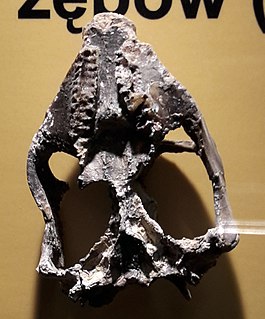 W
WMassetognathus is an extinct genus of plant-eating traversodontid cynodonts. They lived during the Triassic Period about 235 million years ago, and are known from the Chañares Formation in Argentina and the Santa Maria Formation in Brazil.
 W
WMussaurus is a genus of herbivorous sauropodomorph dinosaur that lived in southern Argentina during the Late Triassic, about 215 million years ago. It receives its name from the small size of the skeletons of juvenile and infant individuals, which were once the only known specimens of the genus. However, since Mussaurus is now known from adult specimens, the name is something of a misnomer; adults possibly reached 6 metres (20 ft) in length and weighed more than 1,000 kilograms (2,200 lb). Mussaurus possesses anatomical features suggesting a close, possibly transitional evolutionary relationship with true sauropods.
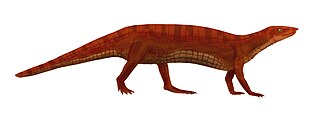 W
WNeoaetosauroides is an extinct genus of primitive aetosaur. Its type and only species is N. engaeus. Fossils have been found in Los Colorados Formation outcropping along the Sierra Morada River in the Ischigualasto-Villa Unión Basin in La Rioja, Argentina, and date back to the Norian age of the Late Triassic. It was the first aetosaur known from the formation, with remains being discovered in the 1960s.
 W
WPanphagia is a genus of sauropodomorph dinosaur described in 2009. It lived around 231 million years ago, during the Carnian age of the Late Triassic period in what is now northwestern Argentina. Fossils of the genus were found in the La Peña Member of the Ischigualasto Formation in the Ischigualasto-Villa Unión Basin. The name Panphagia comes from the Greek words pan, meaning "all", and phagein, meaning "to eat", in reference to its inferred omnivorous diet. Panphagia is one of the earliest known dinosaurs, and is an important find which may mark the transition of diet in early sauropodomorph dinosaurs.
 W
WThe Paso Flores Formation is a latest Late Triassic (Rhaetian) geologic formation in the Neuquén Basin of Neuquén Province in northwestern Patagonia, Argentina. The brown to red-stained conglomerates, sandstones and shales of the formation represent the youngest and only latest Triassic edimentary unit in the country, overlying basement.
 W
WPelorocephalus is an extinct genus of chigutisaurid temnospondyls from the Late Triassic (Carnian) Cacheutá Formation of the Cuyo Basin and the Ischigualasto Formation of the Ischigualasto-Villa Unión Basin, both in northwestern Argentina. Three species are currently recognized: the type species C. mendozensis, which was named in 1944, P. tenax, which was named in 1949 as a species of Chigutisaurus and reassigned to Pelorocephalus in 1999, and P. cacheutensis, which was named in 1953 as another species of Chigutisaurus and reassigned to Pelorocephalus along with P. tenax. A fourth species, P. ischigualastensis, was named in 1975 after the formation it was found in. The species P. tunuyanensis was named in 1948 but has since been synonymized with P. mendozensis. The largest individuals are estimated to have been over 107 centimetres (42 in) in length.
 W
WPholadomya is a genus of saltwater clams, marine bivalve molluscs in the family Pholadomyidae.
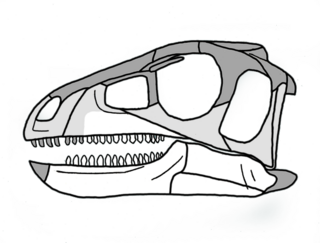 W
WPisanosaurus is an extinct genus of primitive dinosauriform that lived approximately 228 to 216 million years ago during the latter part of the Triassic Period in what is now South America. It was a small, lightly-built, ground-dwelling herbivore, that could grow up to an estimated 1 m (3.3 ft) long. Only one species, the type, Pisanosaurus mertii, is known, based on a single partial skeleton discovered in the Ischigualasto Formation of the Ischigualasto-Villa Unión Basin in northwestern Argentina.
 W
WProbainognathus meaning “progressive jaw” is an extinct genus of cynodonts that lived around 235 to 221.5 million years ago, during the Late Triassic in what is now South America. Probainognathus is a member of the family Probainognathidae, and is a close relative of the family Chiniquodontidae. The various similarities to Chiniquodontidae led Alfred Romer to initially suggest Probainognathus be placed within that family, but it was subsequently decided that the differences were enough to warrant its placement within Probainognathidae.
 W
WProterochampsa is a genus of proterochampsid archosauromorph from the Late Triassic (Carnian) Cancha de Bochas Member of the Ischigualasto Formation in the Ischigualasto-Villa Unión Basin in northwestern Argentina and the Alemoa Member of the Santa Maria Formation in the Paraná Basin in southeastern Brazil. It normally measured about 1.8 to 2 m, though P. barrionuevoi, known from a 44 centimetres (17 in) skull, could have grown up to 3.5 m (11 ft).
 W
WPseudhesperosuchus is a genus of sphenosuchian, a type of basal crocodylomorph, the clade that comprises the crocodilians and their closest kin. It is known from a partial skeleton and skull found in rocks of the Late Triassic (Norian-age) Los Colorados Formation of the Ischigualasto-Villa Unión Basin in northwestern Argentina.
 W
WPseudochampsa is an extinct genus of proterochampsid archosauriform known from the Late Triassic (Carnian) Cancha de Bochas Member of the Ischigualasto Formation of San Juan Province, Ischigualasto-Villa Unión Basin in northwestern Argentina. It contains a single species, Pseudochampsa ischigualastensis, originally named as a second species of the closely related Chanaresuchus, based on a fairly complete articulated skeleton and skull. A revision of the remains concluded that it was best to move to species to its own genus, as no traits were found to unite P. ischigualastensis and the type species of Chanaresuchus to the exclusion of other proterochampsids. A phylogenetic analysis places both species in a polytomy with Gualosuchus as the most advanced members of Proterochampsia.
 W
WThe Quebrada del Barro Formation is a geological formation of the Marayes-El Carrizal Basin in San Juan Province, Argentina. This formation is the most fossiliferous portion of the Triassic Marayes Group, and is also the youngest unit of the group, overlying the El Carrizal Formation. An unconformity at the top of the Quebrada del Barro Formation separates it from the Cretaceous-age Los Riscos Formation of the El Gigante Group. Part of the formation may be made into a provincial park following the discovery of the fossils of Ingentia, a giant sauropodomorph dinosaur which helped elucidate the early evolution of sauropods.
 W
WThe Río Seco de la Quebrada Formation is a Triassic geological formation in Mendoza Province, Argentina. Fossils of cynodonts such as Cynognathus, Diademodon, and Pascualgnathus have been found in this formation, along with dicynodonts such as Vinceria and Kannemeyeria. Based on biostratigraphy, the Río Seco de la Quebrada Formation is considered to have formed during the Anisian stage, as it shares fauna with the upper subzones of the Cynognathus Assemblage Zone in South Africa. However, radiometric dating controversially argues that it was deposited during the early Carnian stage, 10 million years younger than expected otherwise.
 W
WRiojasaurus was a herbivorous sauropodomorph dinosaur named after La Rioja Province in Argentina where it was found in the Los Colorados Formation in the Ischigualasto-Villa Unión Basin by José Bonaparte. It lived during the Late Triassic and grew to about 10 metres (33 ft) long. Riojasaurus is the only known riojasaurid to live in South America.
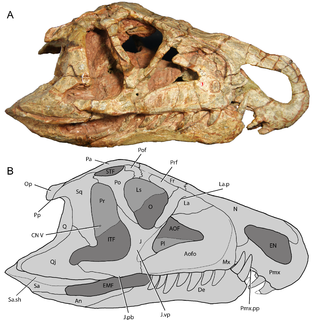 W
WRiojasuchus is an extinct genus of Late Triassic (Norian) quadrupedal crurotarsan archosaur. Riojasuchus is a member of Ornithosuchidae, a family of facultatively bipedal carnivores that were geographically widespread during the Late Triassic. Two other genera, Ornithosuchus and Venaticosuchus, are currently known. The holotype specimen is PVL 3827. It was found in the Los Colorados Formation of the Ischigualasto-Villa Unión Basin in northwestern Argentina.
 W
WSagenopteris is a genus of extinct seed ferns from the Triassic to late Early Cretaceous.
 W
WSanjuansaurus is a genus of herrerasaurid dinosaur from the Late Triassic (Carnian) Cancha de Bochas and La Peña Members of the Ischigualasto Formation of the Ischigualasto-Villa Unión Basin in northwestern Argentina.
 W
WSaurosuchus is a genus of large loricatan pseudosuchian archosaur that lived in South America during the Late Triassic period. It was a heavy, ground-dwelling, quadrupedal carnivore, being the major predator in the Ischigualasto Formation.
 W
WSillosuchus is a genus of shuvosaurid poposaurid archosaur that lived in South America during the Late Triassic period. Shuvosaurids were an unusual family of reptiles belonging to the group Poposauroidea; although their closest modern relatives are crocodilians, they were bipedal and lightly armored, with dinosaur-like hip and skull structures. Based on skull remains from members of the family such as Effigia, they were also toothless and likely beaked herbivores.
 W
WThe Talampaya Formation is an Early Triassic (Olenekian) geologic formation in the Ischigualasto-Villa Unión Basin of La Rioja Province in northwestern Argentina. The pink to red sandstones of the formation represent the oldest sedimentary unit in the basin, overlying basement rock and were deposited in a high-energy braided river environment. Ichnofossils, probably left by an archosaur chirotherian, were found in the formation. The formation crops out in the Talampaya National Park, which was designated a UNESCO World Heritage Site in 2000.
 W
WThe Tarjados Formation is an Early to Middle Triassic geologic formation in the Ischigualasto-Villa Unión Basin of La Rioja Province in northwestern Argentina. The red to whitish sandstones and conglomerates of the formation were deposited in an arid fluvial environment. The formation overlies the Talampaya Formation and is overlain by the Chañares Formation of the Agua de la Peña Group.
 W
WTrialestes is an extinct genus of Late Triassic (Carnian) crocodylomorphs that lived in South America. It has been classified as a dinosaur in the past due it being adapted as a terrestrial, running carnivore. It is classified in Sphenosuchia, which were early relatives of crocodylians. Irmis, Nesbitt and Sues (2013) noted that some of the material referred to this taxon is actually dinosaurian; however, according to the authors, the holotype specimen PVL 2561, found in the Cancha de Bochas Member of the Ischigualasto Formation in the Ischigualasto-Villa Unión Basin in northwestern Argentina, "comprises a single individual that preserves unambiguous crocodylomorph synapomorphies", indicating it is indeed a crocodylomorph, and one of the referred specimens, PVL 3889, does share one or more autapomorphies with the holotype, indicating it represents the same taxon. The type species, T. romeri, was named in 1963.
 W
WVenaticosuchus is a genus of pseudosuchian archosaurs from the family Ornithosuchidae. Known from a single species, Venaticosuchus rusconii, this genus is described based on an incomplete skull and jaw collected from the Late Triassic (Carnian) Ischigualasto Formation in the Ischigualasto-Villa Unión Basin in northwestern Argentina, which was deposited around 230 million years ago. This fossil material has been termed the holotype specimen PVL 2578. Venaticosuchus incorporated a myriad of features present in the other two genera of ornithosuchids, Ornithosuchus and Riojasuchus. However, it also had several unique traits, relating to the lower jaw.
 W
WZupaysaurus is a genus of early theropod dinosaur living during the Norian stage of the Late Triassic in what is now Argentina. Fossils of the dinosaur were found in the Los Colorados Formation of the Ischigualasto-Villa Unión Basin in northwestern Argentina. Although a full skeleton has not yet been discovered, Zupaysaurus can be considered a bipedal predator, up to 4 metres (13 ft) long. It may have had two parallel crests running the length of its snout.